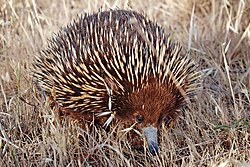The echidna is a mammal that lays eggs, with a similar appearance to the platypus. This animal with spines like a hedgehog, a snout like an anteater, and a gait like a mole, is one of the few mammals with electric abilities.
There are few electric animals in the world, and most of them are fish, which is why this mammal surprised experts. The echidna, or “Tachyglossidae,” belongs to the Monotremata family, just like the platypus. These animals have tiny electroreceptors in their snout, which allows them to detect currents and to dig in the mud, as well as on solid ground.
This feature helps them locate prey with their eyes closed, sharpening their sense of smell, thanks to the tactile electroreceptors on their face, allowing them to locate ant and termite colonies that make up a large part of their diet.
The surprising electric ability of the echidna is much more remarkable than that of other animals, especially those on land, as it is more difficult for them to conduct electricity.

What are the other animals with electric abilities?
As mentioned earlier, most electric animals are aquatic, like:
- Electric eel: this animal produces the highest electric discharge of all known animals. This is due to its nervous system containing electrolytes, electrogenic cells that produce electricity.
- Electric knifefish: this fish is also known for transmitting electricity.
- Electric catfish: like the others, it can generate electricity.
- Atlantic torpedo: in this case, this fish uses electricity for defense.
- Electric ray of the species Leucoraja erinacea: this fish species produces electricity to stun its prey.
- Lesser electric ray (Scyliorhinus retifer): like the previous one, it uses its electricity to attack its prey.
- Marbled electric ray: this animal uses electricity to capture small fish and crustaceans.
- Stargazer: this species uses electricity to detect prey and repel predators.
- Thornback ray (Raja clavata): it is also known for using electricity to locate and capture small crustaceans.
Most of these fish are characterized by being nocturnal and living in freshwater, such as murky rivers and lakes, where they produce weak electric discharges.
Do you already know our YouTube channel? Subscribe!

